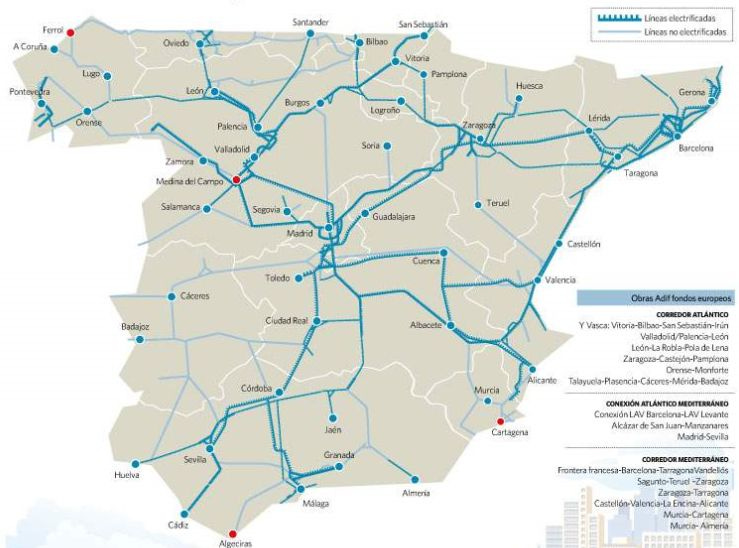9) Hidrógeno en el sector ferroviario
El transporte por ferrocarril es la forma más sostenible que disponemos actualmente para transportar pasajeros y mercancías largas distancias, siendo dicho modo de transporte excepcionalmente seguro, conectando personas y empresas de la Unión Europea a través de la Red Transeuropea de Transporte (RTE-T). Aunque solamente el 7 % de los pasajeros y el 11 % de las mercancías viajan en ferrocarril.
En la UE, el ferrocarril es responsable de <0,5% de las emisiones de gases de efecto invernadero del transporte. Estas emisiones se generan al usar diésel para propulsar los trenes en zonas donde la electrificación no es viable.
Según los datos consultados del año 2021, en España las vías electrificadas ascienden a 9984 km, en cambio, las no electrificadas son 5536 km (aprox. un 35%). En el siguiente mapa podéis ver los tramos electrificados. Aunque esta relación parece que muchos utilizamos trenes propulsados por diésel, esto no es así. En concreto, la red de Cercanías, que acumula el 90% de usuarios del ferrocarril en España, está electrificada en más de un 75%.
Los expertos coinciden en que electrificar toda la red carece de lógica por el sobre coste que ello conlleva. Por disponer de una relación aproximada, por cada 1 km de catenaria, se estima un precio de 500.000€. En el hipotético caso que fuese viable técnicamente, la factura supondría +2800M€.
De ahí que el hidrógeno emerja como la alternativa sostenible, verde y eficiente en el futuro del transporte ferroviario para las vías no electrificadas. Dado que no solo elimina las emisiones de CO₂ del diésel, sino que reduce la contaminación acústica. Análogamente, aporta un avance a la hora de planificar nuevas líneas pues, al eliminar el coste de la electrificación, permite una gran flexibilidad en el trazado de las rutas.
En el País Vasco dos grandes actores del Corredor Vasco del Hidrógeno han apostado por esta tecnología:
-CAF (Construcciones y Auxiliar de Ferrocarriles) lidera el proyecto FCH2Rail para adaptar un tren Civia y convertirlo en un prototipo con un nuevo sistema de hibridación de la energía de pilas de hidrógeno y baterías. De esta manera, el tren podrá circular en modo eléctrico en una infraestructura con catenaria, y en sistema híbrido en los tramos sin cables.
-Talgo, por su parte mediante la planta de Rivabellosa (Álava), quiere convertir el tren Vittal One en la primera locomotora "dual" de un fabricante español, es decir, que puede funcionar con un motor conectado a la electricidad de la catenaria o por una batería alimentada por hidrógeno.
En Europa Alstom concluyo con éxito las pruebas del tren de pasajeros CoradiaiLint con pilas de combustible de hidrógeno en Países Bajos durante 2020. Dicho tren dispone de una autonomía de 1000km y 15 minutos de repostaje. A nivel europeo hay un mercado potencial de +5000 trenes diesel y diversos países europeos están incorporando hidrógeno para descarbonizar su red ferroviaria.
9) Hydrogen in the railway sector
Rail transport is the most sustainable way that we currently have to transport passengers and goods over long distances, this mode of transport being exceptionally safe, connecting people and companies in the European Union through the Trans-European Transport Network (TEN-T). Although only 7% of passengers and 11% of freight travel by rail.
In the EU, rail is responsible for <0.5% of greenhouse gas emissions from transport. These emissions are generated by using diesel to power trains in areas where electrification is not feasible.
According to the data consulted for the year 2021, in Spain the electrified roads amount to 9984 km, on the other hand, the non-electrified ones are 5536 km (approx. 35%). On the following map you can see the electrified sections. Although this relationship seems to make many of us use diesel-powered trains, this is not the case. Specifically, the Cercanías network, which accumulates 90% of railway users in Spain, is more than 75% electrified.
Experts agree that electrifying the entire network lacks logic due to the extra cost that this entails. By having an approximate relationship, for every 1 km of catenary, a price of €500,000 is estimated. In the hypothetical case that it were technically feasible, the invoice would amount to +2800M€.
Hence, hydrogen emerges as the sustainable, green and efficient alternative in the future of rail transport for non-electrified tracks. Since it not only eliminates CO₂ emissions from diesel, but also reduces noise pollution. Similarly, it provides an advance when planning new lines because, by eliminating the cost of electrification, it allows great flexibility in the routing of routes.
In the Basque Country, two major players in the Basque Hydrogen Corridor have opted for this technology:
-CAF (Construcciones y Auxiliar de Ferrocarriles) leads the FCH2Rail project to adapt a Civia train and turn it into a prototype with a new system for hybridizing energy from hydrogen cells and batteries. In this way, the train will be able to circulate in electric mode in an infrastructure with catenary, and in a hybrid system in the sections without cables.
-Talgo, for its part, through the Rivabellosa (Álava) plant, wants to turn the Vittal One train into the first "dual" locomotive from a Spanish manufacturer, that is, it can work with a motor connected to the electricity from the catenary or by a hydrogen-powered battery.
In Europe Alstom successfully completed the tests of the CoradiaiLint passenger train with hydrogen fuel cells in the Netherlands during 2020. This train has a range of 1000km and 15 minutes of refueling. At the European level there is a potential market of +5000 diesel trains and various European countries are incorporating hydrogen to decarbonise their rail network.






